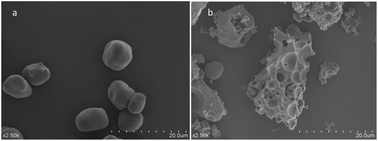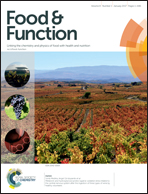A comparison of RS4-type resistant starch to RS2-type resistant starch in suppressing oxidative stress in high-fat-diet-induced obese rats†
Abstract
The anti-obesity effects of two types of resistant starch (RS) in high-fat-diet-induced obese rats were investigated. The serum triglycerides, total cholesterol and malondialdehyde concentrations were significantly reduced, and the total antioxidant capacity, superoxide dismutase levels and glutathione peroxidase activity were increased by RS2 and RS4 consumption compared to the obesity group. A significant reduction in the serum glucose level and elevations in hepatic lipid metabolic enzyme activities were observed only for RS4 administration. Moreover, the expression levels of the fatty acid synthesis associated genes ACC and Fads1, the triglyceride synthesis and metabolism-related gene SREBP-1, the adipocyte differentiation gene PPARγ, the cholesterol synthesis associated gene HMGCR, and the gluconeogenesis associated gene GAPDH were all significantly down-regulated, whilst the lipid oxidation gene Acox1 and the liver function genes Gsta2, Nqo1, and Gclm were up-regulated in both administered groups. Additionally, RS4 performed well in up-regulating the expressions of Gsta2, Gsta3, Nqo1, and Egfr, and down-regulating LXRα, Igfbp1, and Pml. RS4 exhibited great advantages in reducing oxidative stress compared with RS2.


 Please wait while we load your content...
Please wait while we load your content...